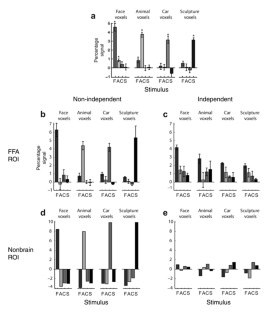Does the fusiform face area contain subregions highly selective for nonfaces? (original) (raw)
- Correspondence
- Published: 01 January 2007
Nature Neuroscience volume 10, pages 3–4 (2007)Cite this article
- 1559 Accesses
- 18 Altmetric
- Metrics details
To the editor:
Grill-Spector and colleagues1 used high-resolution fMRI (1 mm isotropic voxels) to argue that the fusiform face area (FFA) is composed not only of voxels highly selective for faces (as previously argued), but also of voxels that are just as selective for nonface stimuli (cars, animals and sculptures). We show here that the authors' analyses are subject to a selection bias that invalidates their claim of strong selectivity for nonfaces.
This is a preview of subscription content, access via your institution
Access options
Subscribe to this journal
Receive 12 print issues and online access
$209.00 per year
only $17.42 per issue
Buy this article
- Purchase on SpringerLink
- Instant access to full article PDF
Prices may be subject to local taxes which are calculated during checkout
Additional access options:
Figure 1: Comparison of results reproduced from Grill-Spector et al. with non-independent and independent analyses of data from FFA and non-brain regions of interest.

References
Author information
Authors and Affiliations
- Laboratory of Brain and Cognition, National Institute of Mental Health, National Institutes of Health, 10 Center Drive, Building 10, Room 4C-104, MSC1366, Bethesda, 20892, Maryland, USA
Chris I Baker - McGovern Institute for Brain Research and Department of Brain and Cognitive Sciences, Massachusetts Institute of Technology, 77 Massachusetts Avenue, Cambridge, 02139, Massachusetts, USA
Tyler L Hutchison & Nancy Kanwisher
Authors
- Chris I Baker
You can also search for this author inPubMed Google Scholar - Tyler L Hutchison
You can also search for this author inPubMed Google Scholar - Nancy Kanwisher
You can also search for this author inPubMed Google Scholar
Supplementary information
Rights and permissions
About this article
Cite this article
Baker, C., Hutchison, T. & Kanwisher, N. Does the fusiform face area contain subregions highly selective for nonfaces?.Nat Neurosci 10, 3–4 (2007). https://doi.org/10.1038/nn0107-3
- Issue Date: 01 January 2007
- DOI: https://doi.org/10.1038/nn0107-3